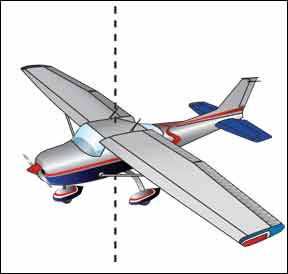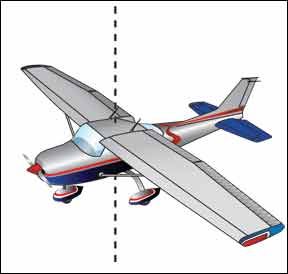Conventional airplanes have three primary flight controls: ailerons to manage rolling about the longitudinal axis, elevators/stabilators to establish and maintain the desired pitch about the lateral axis, and a rudder to deal with any yawing moments around the vertical axis. All three of these axes meet and pass through the airplanes center of gravity and, when used correctly, are coordinated to produce smooth, efficient flight. If one spends much time listening to the old-timers populating FBO pilot lounges, todays pilots dont know how to use the rudder to 288 manage yaw, especially when flying an older airplane or one with a tailwheel. For the most part, theyre right-few pilots trained in a modern, tricycle-gear airplane or coming out of the various “puppy farms” use the rudder skillfully. That doesnt mean those pilots are unsafe; it just means the airplanes theyve flown are designed so as to not require good rudder skills to fly smoothly. (Once they move into multi-engine airplanes, they tend to get rudder religion; if they ever earn the taildragger endorsement, they tend to become members of the choir.) Regardless, one of the keys to effective rudder use is understanding yaw. In other words, before we can understand everything the rudder has to offer, we have to understand how and why the airplane yaws about its vertical axis. It comes in different flavors, and from different sources. Adverse Yaw A type of yaw with which most of us are familiar is adverse yaw, produced by aileron deflection. The sidebar at right discusses in greater detail how adverse yaw is generated. Its effect is to yaw the airplanes nose in the direction opposite the desired turn when the ailerons are deflected. Adverse yaw works to retard the ailerons effectiveness by delaying the airplanes heading change until either corrected with rudder or the bank angle forces heading change in the desired direction. In extreme examples-chiefly older airplanes employing early aileron design and sailplanes with wide control surfaces-casual aileron input slews the airplanes nose in the opposite direction. The turn wont begin until rudder is applied in the turns desired direction. Shallow banks can be established without any heading change, thanks to adverse yaw. Since thats not necessarily desirable aerodynamic behavior, improved aileron designs were developed to minimize it. Again, those pilots familiar only with modern airplanes employing ailerons designed to minimize adverse yaw havent had much, if any, experience with adverse yaw and have grown accustomed to a rather immediate roll in the desired direction after aileron input. However, regardless of how modern the airplane is or how well-designed are its ailerons, theres going to be some adverse yaw generated whenever aileron input is applied. Compensating for adverse yaw is as easy as adding rudder input simultaneously with aileron-or even adding it before beginning a roll if the airplanes design requires it. One of the keys here is knowing the airplane will want to yaw away from the intended turn direction, anticipating that behavior and compensating for it. This isnt rocket science, but using the rudder at the same time as we apply aileron is the hallmark of a skilled, competent pilot. It also helps ensure a coordinated turn, something for which we should be striving anyway. Torque and the Slipstream Another type of yaw with which we should be concerned is the torque and P factor generated in powered airplanes, as distinguished from sailplanes and gliders. Although these are separate and distinct effects created by virtue of having a propeller, they often act in concert with each other to generate yawing moments. Torque is one result of having an engine mounted on the airplane and exerts a force opposite the airplane engines direction of rotation. It is the reason we need to add right rudder when applying full power for takeoff to an airplane with a front-mounted, clockwise-turning propeller when viewed from the cockpit (i.e., most of them in the U.S.) as the nose begins slewing off to the left. Once airborne, torque tends to force the airplane into a roll to the left (again, when considering a clockwise-turning propeller). Just as with adverse yaw, aircraft designers have employed various “tricks” to compensate for torques effects. For example, on some airplanes-mid-1960s and later Bonanzas are a good example-the engine mounts are canted slightly to starboard. Older aircraft may be designed or properly rigged so the left wing sees a slightly greater angle of attack, thus generating more lift and compensating for the leftward-rolling effect torque generates. Compounding this left-turning tendency in powered airplanes is the slipstream, or corkscrew effect, resulting from the propellers rotation. As the nose-mounted propeller rotates, it generates a spiralling air column, moving aft. Since this air is moving aft and rotating in the same direction as the propeller-visualize a wing-generated vortex-it eventually will strike the vertical stabilizers left side, pushing it to the right. What happens when a force is exerted on the left side of the vertical stabilizer? Thats right-the tail is pushed right and the nose moves to the left as the airplane rotates about its vertical axis. Like torque, the slipstream/corkscrew effect is most pronounced in low airspeed/high power situations, such as experienced during slow flight or initial climb after takeoff. Thats why we need more right rudder on initial climb and when doing slow-flight work than when in cruise. Also and like with torque, designers have developed ways to minimize it. As an example, vertical stabilizers may be offset slightly left to generate a right-turning tendency. Rudder trim helps, too. P factor And Gyroscopes Having a front-mounted engine driving a propeller creates all kinds of aerodynamic mischief. The effects of torque and the slipstream are two examples; P factor-also called asymmetric loading-and the props gyroscopic effect are two more. Both result from having a propeller spinning away out in front of the airplane. Their effects change with the airplanes angle of attack. Of course, P factor is closely related to torque since both effects are at their most pronounced in high-power, low-airspeed situations. Rather than being caused by the engine, however, P factor results from a downward-moving propeller blade being at a greater angle of attack and generating more lift in a nose-high attitude than when its ascending. Its direct relationship to the propeller is also how it got its name. When considering airplanes with nose-mounted single engines and clockwise-turning propellers, the prop blade moves downward when its on the right side of the fuselage (again, when viewed from the cockpit). Thanks to the airplanes nose-up angle of attack, the downward-moving blade on the right generates greater lift because it moves more air. The result pushes the nose left. In addition to being sensitive to the airplanes angle of attack, a spinning propeller makes a great gyroscope and exhibits behavior similar to the gyro-based flight instruments in the panel. One of these behaviors is precession, which is what happens to a spinning gyroscope when a deflecting force is applied to it. The resulting force acts 90 degrees ahead of and in the gyroscopes direction of rotation. A common example of the rotating propellers gyroscopic behavior involves an airplane equipped with conventional landing gear-a taildragger-on its takeoff roll. As the taildraggers tail is raised-and its nose/propeller lowered-during the takeoff roll, gyroscopic precession occurs. The result is a yawing moment to the left-90 degrees ahead of and in the direction of rotation. Of course, taildraggers arent the only airplanes affected. Any deflection of the propeller out of its plane of rotation causes precession, so tricycle-gear airplanes also are affected. We normally dont raise the tail and lower the nose during their takeoff roll, of course. However, gyroscopic precession affects them (and taildraggers) at other times, like when abruptly raising or lower the nose while airborne. Raising the nose will generate a yawing moment to the right; we already covered what happens when lowering the nose. Importantly, gyroscopic precession manifests itself not only around the vertical axis but the lateral one, also. As the FAAs Pilots Handbook of Aeronautical Knowledge, FAA-H-8038-25A, states, “any yawing around the vertical axis results in a pitching moment, and any pitching around the lateral axis results in a yawing moment. To correct for the effect of gyroscopic action, it is necessary for the pilot to properly use elevator and rudder to prevent undesired pitching and yawing.” In other words, we always need to use the primary flight controls in a coordinated fashion to ensure the airplane flies correctly and efficiently. Which is pretty much where we came in. Mastering Yaw Movement around the airplanes vertical axis-yaw-is a natural and predictable aerodynamic response to various other things going on in and around an airplane. We can understand and compensate for it, or we can allow it to slew the airplanes nose around the sky, forcing us to wallow in and out of turns, and wreaking havoc in high-power, low-airspeed situations. If pilots had a better understanding of its sources and ways to counter it, wed have happier passengers and reduced runway-loss-of-control accidents. Wed also be happier with our piloting skills, and perhaps less hesitant to use them.




